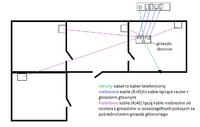So you need 5 sockets, and whether you earn them as RJ45 or as RJ11 makes no difference,
Unfortunately, you have to choose an 8-port panel for this purpose.
What is the amount and requirements you set, the easiest way would be to lead the cables to a cabinet, and plug them into the router without unnecessary costs.
Either way, you either buy single socket modules and put them together in what looks like a patch panel, or you buy an 8 socket module.
Well, unless you convince someone, or you buy an old router yourself and solder these 4 LAN + 1 ADSL sockets.
In addition, if you ever decide to use neostrada with a phone and Livebox, you will miss one RJ11 connection - the entire cable.
I am only interested in the cost of this solution, because 2 good Wifi cards for the stationer will come out cheaper than the entire IT infrastructure you have planned.
PS ETHERNET cable and not enthernet.
in the picture you have a rauter - but in the following statements you already write correctly router.




